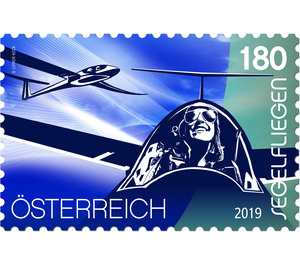Series: Sports - Sport and air - gliding - Austria / II. Republic of Austria 2019 - 180 Euro Cent
Theme: Sports & Games
| Country | Austria / II. Republic of Austria |
| Issue Date | 2019 |
| Face Value | 180.00 |
| Color | white violet blue |
| Printing Type | offset |
| Stamp Type | Commemorative |
| Item Type | Stamp |
| SID | 122258 |
| Dimensions | 50.00 x 32.00 |
| In 75 Wishlists | |
The “Sports” series launched in 2018 focuses on both popular and less well-known sports. This year the three stamps from this series are dedicated to sports which are practised high in the air. Flying without an engine: Otto Lilienthal made the first attempts with a glider at the end of the 19th century. The Wright brothers also developed a double-decker glider plane, which they ultimately fitted with an engine in 1903. However, at the end of the First World War the Treaty of Versailles specified that the defeated nations were not allowed to use motorised aeroplanes, which once again fuelled interest in gliding. During this period the first gliding competitions were held in the Rhön Mountains in Germany. From the 1920s on, gliding became increasingly important in Austria, with one of the most significant pioneers of flight at this time being Robert Kronfeld, who was able to set many records. The power of nature: Put simply, gliding is flying without an engine. Consequently, the shape of a glider is particularly aerodynamic and optimised for gliding. However, a glider does need help to get up in the air: it is either launched into the air by means of a winch or is towed behind a motorised plane. After being uncoupled, the glider glides downwards in accordance with the laws of physics. The wind and the sun ensure that the glider does not fall quickly back to the ground: the air warmed by the sun rises and, by circling, the pilot is able to make use of the updraughts created by these thermals or of ridge lifts to regain height and also to gain speed. The forces in action here can propel a glider travelling at up to 250 km/h over distances of more than a thousand kilometres. Mastering the machine requires basic training comprising both practical and theoretical components as well as the pertinent examinations. A good understanding of aerodynamics is as important as knowledge of meteorology and about how the terrain below affects the flight. On the special stamp a pilot and a glider can be seen in the air. In keeping with the topic “Sport and air”, the colour contrast and the stamp’s design remind one of airflows.


